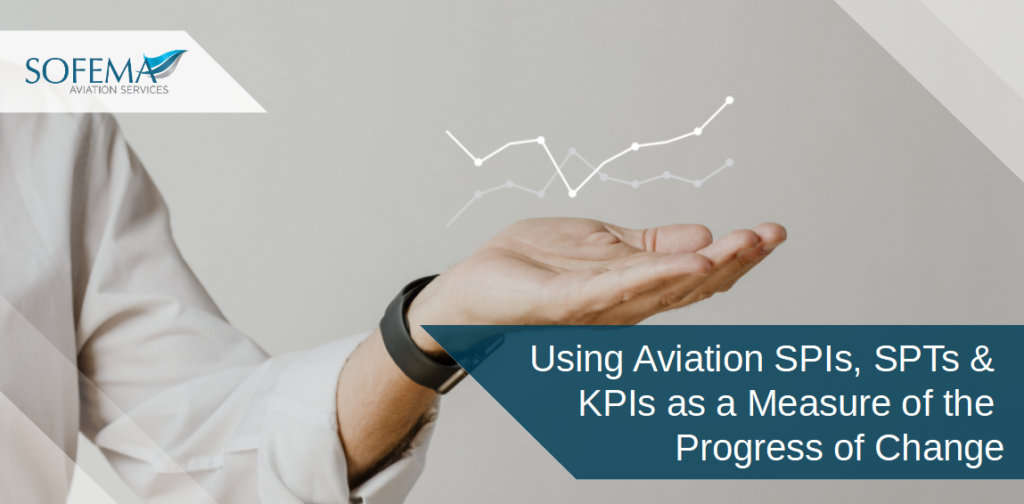Sofema Aviation Services (SAS) www.sassofia.com considers the challenges of effectively engaging with Safety Performance Indicators (SPI), Safety Performance Targets (SPT), and Key Performance Indicators (KPI) and using the information to support the Management of Change.
Introduction
The use of aviation safety performance indicators (SPI), safety performance targets (SPT), and key performance indicators (KPI) is critical in measuring the progress of change in the aviation industry.
- These metrics provide a reliable and measurable way to assess the effectiveness of safety initiatives and identify areas for improvement.
- Their effective use requires significant investment, expertise, and a culture of safety within the organization.
- Note also there are challenges associated with developing, measuring, and interpreting these metrics, as well as the need for continuous to reflect the changing nature of safety risks.
- Nonetheless, the potential benefits of using SPIs, SPTs, and KPIs are substantial and can help to ensure the safety of all elements of the aviation system.
An airline may use SPIs such as accident rates, incident rates, and safety-related delays to evaluate its safety performance. The airline may then set SPTs to reduce accident rates, incident rates, and safety-related delays by a certain percentage over a specified period. The airline may then use KPIs such as safety audit results, safety inspection results, and safety training completion rates to measure the effectiveness of its safety management system in achieving these targets.
SPI Introduction
Aviation Safety Performance Indicators (SPIs) are measurements of an organization’s safety performance, used to determine the effectiveness of safety systems, processes, and activities.
- They are used to assess an organization’s level of safety performance, identifying areas of strength and weakness.
- SPIs are an important tool for monitoring and improving aviation safety performance, but they can be challenging to develop, measure, and interpret.
o Identifying which SPIs are the most meaningful and effective for measuring safety performance is not always straightforward.
o Collecting data for SPIs can be time-consuming, and measuring the effectiveness of safety initiatives can be difficult due to the lack of clear cause-and-effect relationships.
Aviation safety performance indicators are quantitative measures that are used to track safety performance over time. They provide a way to assess the effectiveness of safety management systems and identify areas where safety can be improved. Examples of aviation safety performance indicators include the number of safety incidents, the severity of incidents, and the rate of incidents per flight hour.
SPIs can be classified into two categories: lagging and leading indicators. Lagging indicators, such as accident rates, measure the occurrence of safety events after they have occurred. Leading indicators, such as safety culture surveys, measure the effectiveness of safety management systems in preventing safety events.
SPT Introduction
Safety Performance Targets (SPTs) are a set of specific, measurable goals that an organization aims to achieve within a specified time frame.
- SPT’s are used to focus efforts and resources toward improving safety performance, and they help to ensure that an organization’s safety initiatives are aligned with its overall goals and objectives.
- SPTs can be challenging to set and achieve, especially if they are ambitious or if the organization lacks the necessary resources to implement the necessary changes.
- SPTs can be difficult to monitor and evaluate, especially if there is a lack of clarity on how to measure progress toward achieving the targets.
Setting SPTs requires a thorough understanding of the organization’s safety performance and the factors that contribute to safety risks. SPTs should be achievable, relevant, and measurable, and they should be reviewed regularly to ensure that they remain relevant.
KPI Introduction
Key Performance Indicators (KPIs) are a set of measurable indicators that are used to monitor an organization’s performance against its strategic goals and objectives.
- KPIs are essential in driving improvements in safety performance and ensuring that an organization’s safety initiatives are aligned with its overall goals and objectives.
- Selecting and defining the right KPIs can be challenging, as the measurement of safety performance is complex and multifaceted.
- KPIs can be challenging to monitor and evaluate, particularly if they are not linked to tangible outcomes or if they are too broad or too narrow in scope.
KPIs are specific, measurable, and time-bound, and they should be aligned with the organization’s safety goals and objectives. KPIs can be used to measure the effectiveness of safety training programs, safety inspections, safety audits, and other safety initiatives.
Important Considerations
The effective use of SPIs, SPTs, and KPIs requires a significant investment of time, resources, and expertise.
There must be a clear understanding of what the metrics are intended to measure, how they will be measured, and how they will be used to improve safety performance.
To be successful requires a culture of safety within the organization, which promotes transparency, accountability, and continuous improvement.
Note – the organization must have access to the necessary data, tools, and resources to effectively monitor and evaluate safety performance.
Final Comments
- When using aviation safety performance indicators, safety performance targets, and key performance indicators as a measure of the progress of change, it is important to ensure that these metrics are relevant to the organization’s safety goals and objectives.
- It is also important to ensure that these metrics are regularly reviewed and updated to reflect changes in the organization’s safety performance and priorities.
- By regularly monitoring and evaluating these metrics, organizations can identify areas where safety can be improved and take action to address these areas.
Next Steps
Follow this link to our Library to find & Download related documents for Free.
Sofema Aviation Services and Sofema Online provide Classroom, Webinar & Online Training of EASA Regulatory Compliant and Vocational Training Courses, for questions please email team@sassofia.com
Tags:
aviation safety, Aviation Industry, KPI, Key Performance Indicators, SAS blogs, Safety Performance Indicators, Safety Performance Targets





